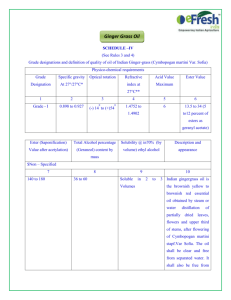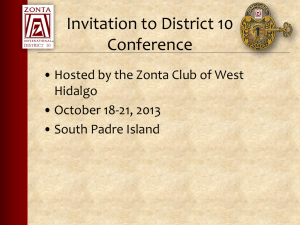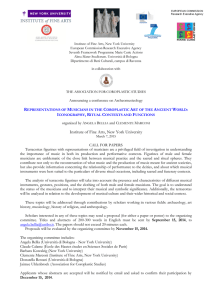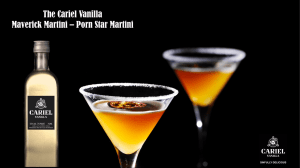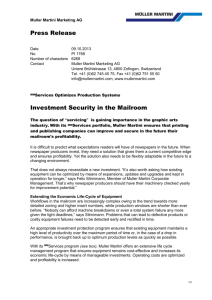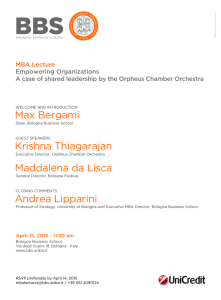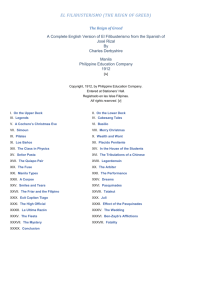G.B. Martini (B. Ramirez)
advertisement
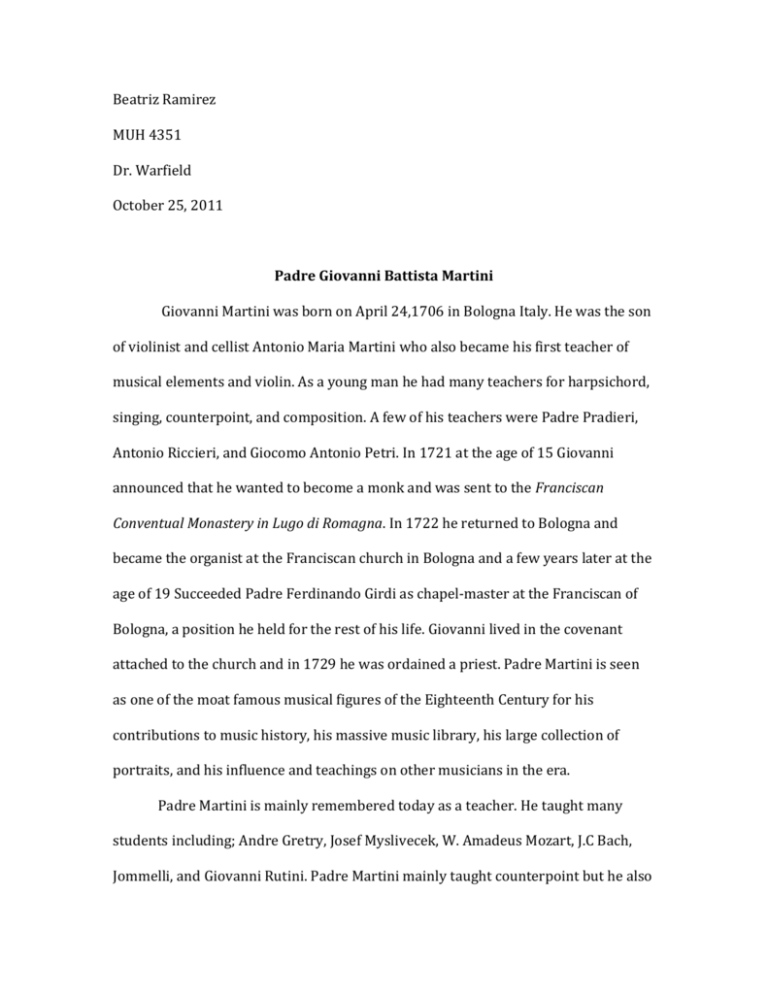
Beatriz Ramirez MUH 4351 Dr. Warfield October 25, 2011 Padre Giovanni Battista Martini Giovanni Martini was born on April 24,1706 in Bologna Italy. He was the son of violinist and cellist Antonio Maria Martini who also became his first teacher of musical elements and violin. As a young man he had many teachers for harpsichord, singing, counterpoint, and composition. A few of his teachers were Padre Pradieri, Antonio Riccieri, and Giocomo Antonio Petri. In 1721 at the age of 15 Giovanni announced that he wanted to become a monk and was sent to the Franciscan Conventual Monastery in Lugo di Romagna. In 1722 he returned to Bologna and became the organist at the Franciscan church in Bologna and a few years later at the age of 19 Succeeded Padre Ferdinando Girdi as chapel-master at the Franciscan of Bologna, a position he held for the rest of his life. Giovanni lived in the covenant attached to the church and in 1729 he was ordained a priest. Padre Martini is seen as one of the moat famous musical figures of the Eighteenth Century for his contributions to music history, his massive music library, his large collection of portraits, and his influence and teachings on other musicians in the era. Padre Martini is mainly remembered today as a teacher. He taught many students including; Andre Gretry, Josef Myslivecek, W. Amadeus Mozart, J.C Bach, Jommelli, and Giovanni Rutini. Padre Martini mainly taught counterpoint but he also taught singing and prepared students for the Academia Filarmonica. Padre Martini had a vast knowledge in the music of the era and past eras and could provide his students with more than enough information but what set him apart as a teacher was his generosity and loveable personality. There was a letter from Mozart which read,” I never cease to grieve that I am far away from that one person in the world that I love, esteem, and revere most of all”. Because of his influence on other musicians and his loveable nature there is a collection of over 6000 letters between him and other musicians including Quantz, Locatelli, Metastasio, and Rameau. This collection is one of the most important sources today for the study of the life and thoughts of musicians in the eighteenth century. Padre Martini lived a comfortable life at the church and used the extra money he received from students to add to his collections. His most important collection was his music library. By the year 1770, 14 years before his death, Martini’s music library consisted of 17,000 volumes. Padre Martini also had a large collection of portraits of the most celebrated musicians from the past and of the modern era. At the time of his death he had around 300 portraits. The collection kept growing through the Nineteenth and Twentieth Centuries and can be viewed at the International Museum and Library of music in Bologna. In 1776 he was elected a member of the Arcadian Academy in Rome and he dedicated himself to composing, writing, and teaching. During his lifetime he did not have many works published, about four of his collections were published and almost all were secular. He was seen as a conservative in his compositions, He wrote contrapuntal pieces in the style of J.S Bach but more often wrote in the homophonic style with the treble voice having more importance. Aside from composing Padre Martini wrote a few books. One of Martini’s most important works is his Storia della Musica which was written in volumes between 1757 and 1781. Only three of the projected five volumes were ever completed and a fourth was in sketches. The series was to provide a musical history dating back to the Ancient Greeks but was never finished and much of the information used cannot be seen today as truly historical. Another important book he wrote was titled Esemplare ,o sia Saggio Fondamentale practico di contrappunto. This book written in two volumes between 1774 and 1776 was intended for his most advanced students. It was a collection of important musical examples from all over with educated commentary on each. Padre Giovanni Battista Martini died in Bologna on August 3, 1784. He spent his whole life living in Bologna, turning down a job offer from the Vatican to live his life in the place he was born. Padre Martini had a large influence on the musicians of his time through his teaching and his correspondence and because of his collections he has given researchers many important sources to study. In Bologna they have a conservatory dedicated to him as well as his collection in their museum and library of music. Bibliography Howard Brofsky and Sergio Durante. "Martini, Giovanni Battista." In Grove Music Online. Oxford Music Online, http://www.oxfordmusiconline.com/subscriber/article/grove/music/17921 (accessed October 25, 2011). Extra Websites http://www.museomusicabologna.it/info.htm
